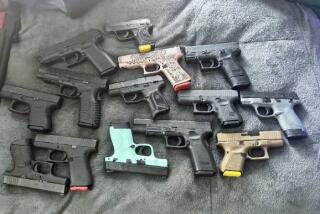A New Method of Home Security
- Share via
GARDEN GROVE — Inventor Phillip Arreguin thinks he has a remedy for the third-leading cause of death among kids 5 to 14: shootings.
He’s patented a lock that secures handguns and rifles alike from within, unlike traditional safeties such as trigger guards, which can still allow a loaded gun to be fired if installed improperly.
Arreguin’s belief that he’s built a better mousetrap comes after eight of the nation’s largest handgun manufacturers announced in October a voluntary agreement--brokered by President Clinton--to supply a child-safety lock with every new weapon sold.
The agreement intercepted a push toward a mandatory gun-lock law last year after Clinton personally appealed for such legislation.
Seventeen California cities and counties already require that trigger locks be sold with guns, including San Jose, San Francisco, Sacramento and West Hollywood.
“Trigger locks have been a craze, at least politically, over the last several months,” said Bill Powers, a National Rifle Assn. spokesman.
It’s all in response to disturbing figures: According to the Centers for Disease Control and Prevention, shootings were the third-leading cause of death nationwide for children ages 5 to 14 in 1994. That same year, according to the FBI, gunshots killed more preschoolers than on-duty police officers. In 1995, Orange County alone saw 90 hospitalizations and three deaths from unintentional shootings, according to state statistics.
But what locks are best and whether locks should be mandatory are still being debated.
Powers said the NRA is opposed to a trigger-lock mandate because the devices aren’t appropriate in all situations.
For example, he said, he has no children at his home, and though he wants to keep his .45-caliber pistol secure, he also wants quick access to it to defend his home if needed. So he keeps it loaded inside a combination-locked box that he can open easily.
“There are literally dozens of ways of storing firearms,” Powers said. “The No. 1 rule of storing a firearm is to keep it from unauthorized persons. It’s common sense.”
Arreguin, 34, says preventing unauthorized use and the tragedy that can follow is the reason he designed his lock, which he calls Tri-Best.
The former stonemason said he came up with the idea in 1993 and has been refining it ever since with his brother, a machinist.
His lock requires no alterations to the gun, he said. A probe fits down the barrel and screws into a companion piece in the gun’s chamber, where the bullet normally is held before it’s fired. When the parts are screwed together, they can’t be removed without damaging the weapon unless a special tool is used.
“If it’s in your glove box, it’s locked, it’s secured,” Arreguin said.
The FBI says it receives about 300,000 reports of stolen firearms every year. That’s why Arreguin suggests that the release tool be kept separate from the gun, a step he said makes the stolen gun useless.
Arreguin, who has yet to find a backer for his project, said he learned this firsthand. While testing a prototype in 1994, Arreguin misplaced his release tool and had to destroy a 9-millimeter Beretta pistol by cutting off the barrel in order to remove the lock.
Firearms security became a matter of law in California in January 1992, when the Children’s Firearm Accident Prevention Act took effect. Like similar legislation passed in 14 other states, it holds adults accountable for the safekeeping of their guns by making it a crime to leave a loaded, unsecured firearm where a child can get to it.
The crime becomes a felony if the minor then injures himself or someone else with the gun. A violation carries up to a three-year prison sentence and a $10,000 fine.
Florida was the first state to pass such a law, in 1989, and unintentional shooting deaths there fell 50% in the first year. A similar drop occurred in California, according to the state Department of Health Services. And gun dealers reported jumps in gun-lock sales.
John Johannessen of Mission Viejo has become an outspoken supporter of gun locks. He knows better than most people the danger of keeping a loaded gun where a child can find it.
In July, his 13-year-old daughter, Shanelle, was shot in the face by a 13-year-old playmate who found a loaded 9-millimeter pistol at her home. She was showing it to Shanelle and it fired.
Shanelle needed reconstructive surgery after the bullet tore through her cheek, jaw and neck. She’s still recovering, and she can now talk and eat soft foods.
“We’re the lucky ones,” Johannessen said. “She’s still alive.
“It’s just horrifying what people go through because adults leave guns lying around,” he said. “People have to be responsible for their guns and keep them locked, so if a child does get hold of it they can’t make it work.
(BEGIN TEXT OF INFOBOX / INFOGRAPHIC)
Weapon Safety
By locking a dummy cartridge into place and closing the gun barrel, the tamper-proof lock prevents a gun from being loaded and fired. It works in essentially the same manner for any kind of gun. Here’s how:
1. Dummy cartridge is placed in firing chamber
2. Keeper is inserted into barrel
3. Master lock twists keeper into dummy cartridge
4. Master lock is detached from keeper, preventing removal of gun lock
Source: United States Patent Office and California Department of Health Services
More to Read
Sign up for Essential California
The most important California stories and recommendations in your inbox every morning.
You may occasionally receive promotional content from the Los Angeles Times.










